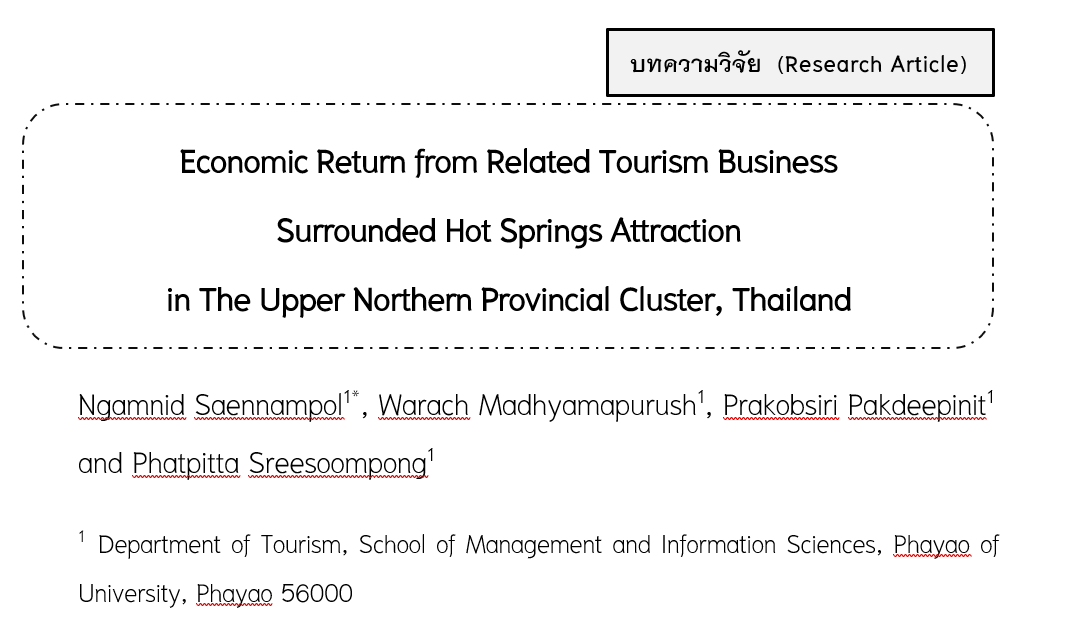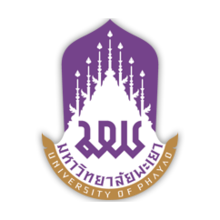Economic Return from Related Tourism Business Surrounded Hot Springs Attraction in The Upper Northern Provincial Cluster, Thailand
Keywords:
Economic Return, Related Tourism Business Surrounded Hot Springs, Upper Northern Provincial ClusterAbstract
The objective of this paper was to study factors effecting the economic return of related tourism businesses surrounded hot springs attraction in the upper northern provincial cluster. Data was collected through in-depth interviews with 32 owners which opened the business at least 1 year, relevant managers or seniors’ staff with the requirement of at least 5 years business experiences. The researcher used the purposive sampling method to get the accurate information from the experiences key informants about related tourism businesses (any of spa, food and beverage, accommodation, community-based tourism and other business) close to Hot spring not more than 10 kilometers, had GPS and accepted to reveal the financial information of their own business. The interviews were recorded and the financial analysis of the net present value (NPV), the Internal Rate of Return (IRR), the benefit-cost ratio (B / C) and the payback period (PB) were scored and interpreted through content analysis. The best economic return business was the small cooperative spa, very small-sized private food and beverage and very small-sized private community-based tourism around Sankampang Hot spring; The cooperative group’s other business around Pong Duet Hot Spring; medium-sized accommodation around private Rungarun resort. In conclusion, most of the related tourism businesses causing the best economic return were either very small private businesses with 1- 5 employees around the co-managed Hot Spring or small cooperative businesses around governmental Hot Spring or medium-sized business around private Hot Spring.
References
Bercovitz, J., and Mitchell, W. (2007). When is more better? The impact of business scale and scope on long‐term business survival, while controlling for profitability. Strategic Management Journal, 28(1), 61-79.
Lepoutre, J., and Heene, A. (2006). Investigating the impact of firm size on small business social responsibility: A critical review. Journal of business ethics, 67(3), 257-273.
Reypens, C., Lievens, A., and Blazevic, V. (2016). Leveraging value in multi-stakeholder innovation networks: A process framework for value co-creation and capture. Industrial Marketing Management, 56, 40-50.
Soontaree Laophatchan and Chatupon Tangkhachat. (2019). Investment decision in international project. Retrieved December 15, 2019, from https://www.ms.src.ku.ac.th/eLearning/Download/DataSheet/2011/Aug/762313/762313%20Chapter8%20Mult%20Cap%20Budgeting.pdf.
Tata, J., and Prasad, S.. (2015). Immigrant family businesses: Social capital, network benefits and business performance. International Journal of Entrepreneurial Behavior and Research, 21(6), 842-86.
Taplah Jr, A. J., Suministrado, D. C., Amongo, R. M. C., Paras Jr, F. O., Elauria, J. C., & Tokpah, D. P. (2018). Economic analysis of duck eggs incubation using hot spring as heat source. Journal of Development and Agricultural Economics, 10(2), 38-44.
Salia, A. M. J., and Alda, M. (2008). Economic analysis of small-scale tilapia aquaculture in Mozambique. Institute Nacional de Desenvolvimento de Aquacultura (INAQUA), 15-16.

Downloads
Published
How to Cite
Issue
Section
License
Copyright (c) 2021 Phayao University

This work is licensed under a Creative Commons Attribution-NonCommercial-NoDerivatives 4.0 International License.
ผู้นิพนธ์ต้องรับผิดชอบข้อความในบทนิพนธ์ของตน มหาวิทยาลัยพะเยาไม่จำเป็นต้องเห็นด้วยกับบทความที่ตีพิมพ์เสมอไป ผู้สนใจสามารถคัดลอก และนำไปใช้ได้ แต่จะต้องขออนุมัติเจ้าของ และได้รับการอนุมัติเป็นลายลักษณ์อักษรก่อน พร้อมกับมีการอ้างอิงและกล่าวคำขอบคุณให้ถูกต้องด้วย
The authors are themselves responsible for their contents. Signed articles may not always reflect the opinion of University of Phayao. The articles can be reproduced and reprinted, provided that permission is given by the authors and acknowledgement must be given.







